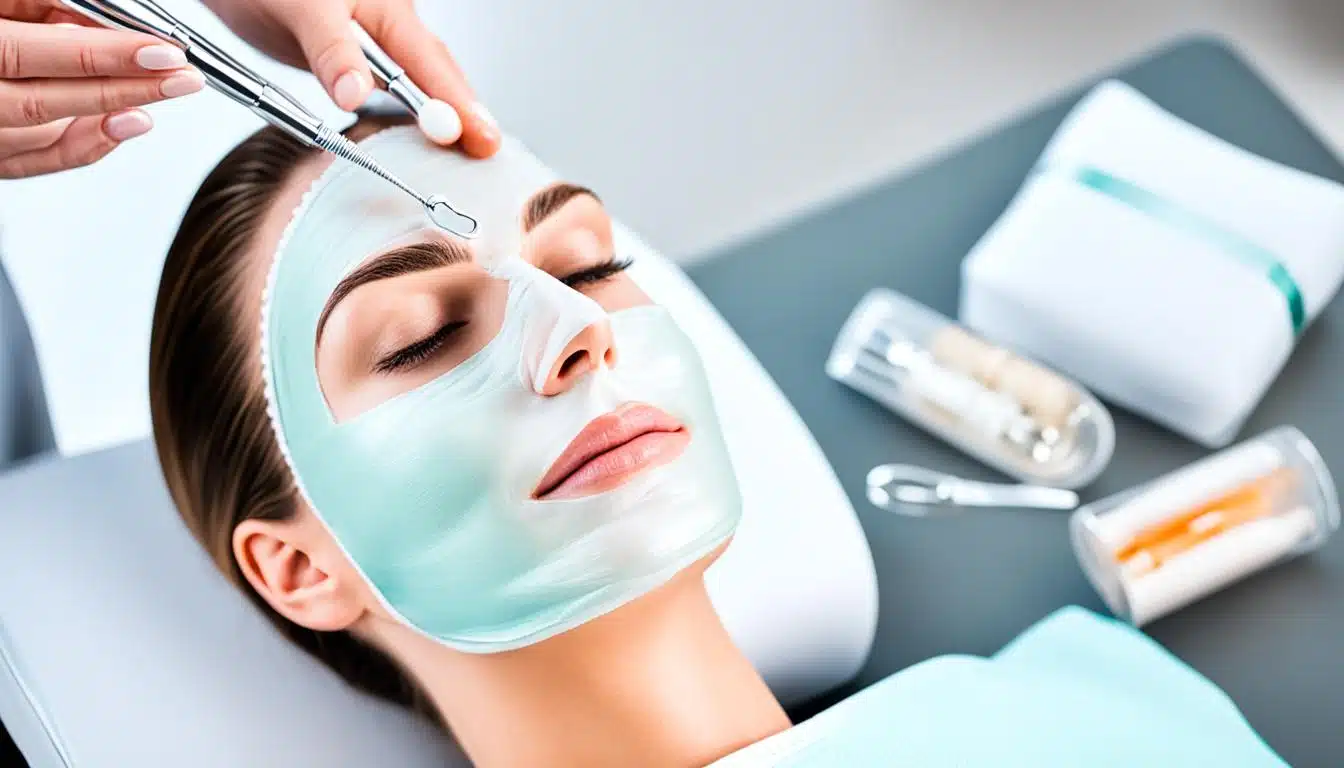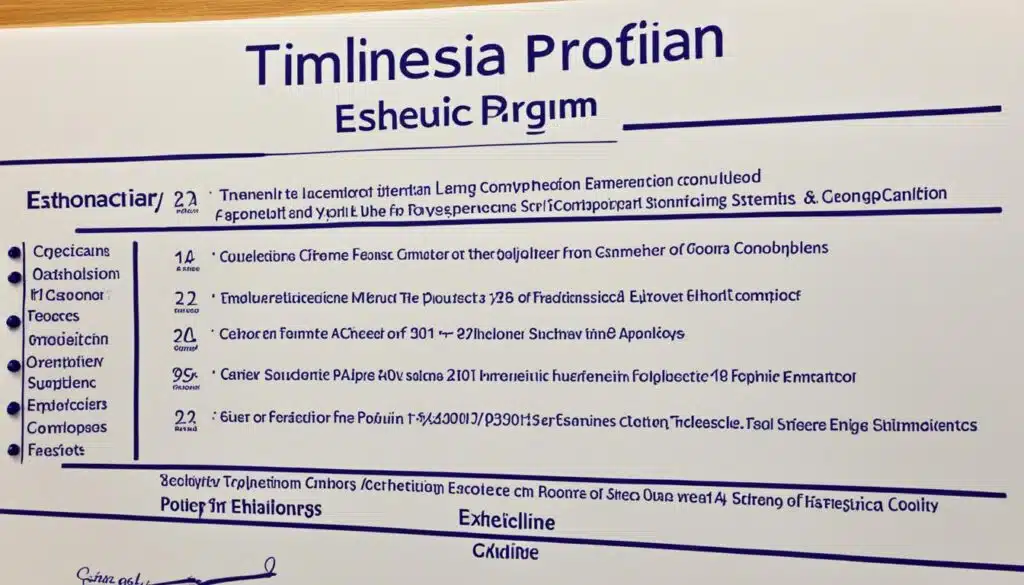Becoming a medical esthetician specialist requires advanced training and specialized knowledge in skincare. These professionals work in spa or medical center settings, providing a wide range of aesthetic treatments and patient care services. Whether it’s administering facials, performing chemical peels, offering makeup consultations, or delivering effective hair removal solutions, medical estheticians play a vital role in helping individuals attain and maintain healthy, radiant skin.
While the term “medical esthetician” implies medical training, there are no legal requirements for this designation. However, estheticians must obtain state licensure and undergo additional study in medical esthetics to become a medical esthetician specialist. With the field of skincare specialists, including medical estheticians, projected to experience significant growth, pursuing advanced training can lead to exciting career opportunities in the beauty and wellness industry.
Key Takeaways:
- Becoming a medical esthetician specialist involves advanced training and specialized knowledge in skincare.
- Medical estheticians work in spa or medical center settings, providing aesthetic treatments and patient care services.
- There are no legal requirements for the title “medical esthetician”, but estheticians must obtain state licensure and undergo additional training.
- Pursuing advanced training as a medical esthetician specialist can lead to a rewarding career in the growing field of skincare.
- Medical estheticians provide a wide range of treatments and services to help individuals achieve healthy, radiant skin.
What Is a Medical Esthetician Specialist ?
A medical esthetician is a licensed skincare expert who works in a clinical environment, such as dermatology offices, plastic surgery clinics, hospitals, or medical spas. While the term “medical” is used, there are no specific legal requirements for medical training. However, estheticians must complete a state-approved cosmetology program, pass licensure exams, and undergo additional training in medical esthetics.
Medical estheticians provide skincare treatments and makeup advice to individuals who have experienced illness, injury, or surgery that has affected their appearance.
Working in a Clinical Environment
Medical estheticians are highly skilled professionals who operate within a clinical setting. They work alongside dermatologists, plastic surgeons, and other medical professionals to provide comprehensive skincare services to their patients. This clinical environment ensures that medical estheticians adhere to strict hygiene and safety protocols, while also giving them access to advanced skincare technology and treatment options.
Collaboration with Healthcare Providers
In dermatology offices, medical estheticians work closely with dermatologists to address various skin concerns, including acne, hyperpigmentation, and aging. At plastic surgery clinics, they play a pivotal role in pre- and post-operative skincare, helping patients optimize their outcomes. In hospitals, medical estheticians provide skincare treatments to patients undergoing medical procedures or recovering from illnesses. They also contribute to holistic care plans to improve patients’ self-esteem and overall well-being.
Specialized Expertise
Medical estheticians have a deep understanding of dermatological conditions and their impact on the skin. They are skilled in performing facial treatments, chemical peels, microdermabrasion, laser procedures, and other aesthetic services. Additionally, they are knowledgeable about skincare product ingredients and can recommend suitable regimens to address individual concerns. By tailoring treatments to each patient’s unique needs, medical estheticians help improve skin health and enhance their clients’ natural beauty.
| Key Tasks of a Medical Esthetician | Workplace Settings |
|---|---|
| Performing facials, chemical peels, and other skincare treatments | Dermatology offices |
| Providing pre- and post-operative skincare to patients | Plastic surgery clinics |
| Administering treatments to patients with medical conditions | Hospitals |
| Offering skincare advice and product recommendations | Medical spas |
“As a medical esthetician, my goal is to help patients regain their confidence and feel great about their skin. By combining my expertise in skincare with the knowledge of medical treatments, I provide tailored solutions that address each person’s unique needs.”
– Emily Johnson, Licensed Medical Esthetician
Medical Esthetician Specializations & Degree Types
In addition to general esthetician training, individuals can pursue specialized medical esthetician programs. These programs are offered by esthetician schools, cosmetology schools, and two-year colleges. They provide education and training in cosmetic medicine, including skincare treatments and procedures used in medical settings.
Specializations may include cosmetic dermatology, which focuses on diagnosing and treating skin disorders and performing aesthetic procedures such as injectable treatments. Graduates of these programs receive an esthetician license and can work as specialized medical estheticians.
These specialized programs combine the foundational knowledge of general esthetician training with the advanced skills required for medical esthetician positions. Students learn about the various aesthetic procedures, including injectable treatments, and gain a deep understanding of cosmetic dermatology.
“The field of medical esthetics is growing rapidly, and there is an increasing demand for professionals who can perform aesthetic procedures and provide specialized skincare treatments.”
By completing these specialized programs, individuals can develop the expertise to work in medical environments, such as dermatology clinics, plastic surgery centers, and medical spas.
Esthetician Schools, Cosmetology Schools, and Two-Year Colleges
Several institutions offer specialized medical esthetician programs:
- Esthetician schools: These schools focus specifically on training estheticians and provide comprehensive education in skincare techniques, including cosmetic dermatology.
- Cosmetology schools: Cosmetology programs often include esthetician training as part of their curriculum. These programs cover both general esthetician skills and specialized medical esthetician techniques.
- Two-year colleges: Some colleges offer two-year degree programs in esthetics or related fields. These programs typically provide a more in-depth education and cover a wider range of medical esthetician specializations.
The Importance of Specialized Training
Specialized medical esthetician training is crucial for individuals who wish to work in the field of cosmetic medicine. In addition to general esthetician skills, specialized programs provide in-depth knowledge of cosmetic dermatology and the latest aesthetic procedures.
Employers in medical and clinical settings often prefer to hire specialized medical estheticians who have received advanced training in these areas. These professionals are equipped to perform a wide range of treatments and provide specialized care to patients.
Advancing in the Field of Medical Esthetics
After completing a specialized medical esthetician program, graduates can pursue various career opportunities. Some may choose to work in dermatology clinics, where they can assist dermatologists in diagnosing and treating skin disorders. Others may find positions in plastic surgery centers, supporting plastic surgeons in pre- and post-operative skincare.
Furthermore, medical estheticians have the option to work in medical spas, combining relaxation and skincare treatments. These professionals are knowledgeable in the use of injectable treatments and can administer procedures such as Botox and dermal fillers.
Overall, specialized medical esthetician training opens doors to a variety of exciting and rewarding career paths in the field of cosmetic medicine and skincare.
Admissions Requirements for Medical Esthetician Programs
When considering a career in medical esthetics, it’s essential to understand the admissions requirements for the various programs available. Admissions requirements may vary depending on the institution, but there are some common prerequisites that prospective students can expect.
To pursue a career as a medical esthetician, most programs require applicants to have a high school diploma or a General Education Development (GED) certificate. This ensures that individuals have completed their secondary education and have a solid foundation to build upon in their esthetician training. The emphasis on education highlights the importance of a strong academic background in this field.
Some programs may have additional entrance requirements based on the quality and duration of the program. These can include specific coursework prerequisites, such as biology or chemistry, or a minimum GPA requirement. These additional requirements aim to ensure that applicants possess the foundational knowledge necessary to excel in the program.
It is crucial for prospective students to research and understand the specific admissions requirements of the programs they are interested in. This information can typically be found on the program’s website or by contacting the admissions office directly. By being aware of these requirements in advance, individuals can adequately prepare and meet the necessary criteria for admission.
Keep in mind that each program may have its own unique set of admissions requirements. While a high school diploma or GED is generally a standard prerequisite, it’s always a good idea to verify with the individual programs you are considering.
Example Admissions Requirements for Medical Esthetician Programs:
| Requirement | Description |
|---|---|
| High School Diploma or GED | Proof of high school graduation or equivalent is required. |
| Minimum GPA | Some programs may have a minimum GPA requirement for admission. |
| Program-Specific Prerequisites | Certain programs may require prerequisite coursework, such as biology or chemistry. |
Understanding the admissions requirements for medical esthetician programs is an important step in pursuing a career in this growing field. With the right education and qualifications, aspiring estheticians can embark on a rewarding journey in the beauty and skincare industry.
How Long Does it Take to Become a Medical Esthetician?
The timeline for becoming a medical esthetician can vary depending on several factors. After high school graduation, individuals interested in pursuing a career in this field can enroll in a medical esthetician program. The duration of these programs typically ranges from nine months to two years, depending on the specific program and the level of training provided.
During their enrollment in a medical esthetician program, students will receive comprehensive education and training in skincare, including theoretical knowledge and hands-on practical experience. They will learn about various aesthetic treatments, skincare techniques, and customer care. This training equips them with the necessary skills to work effectively in clinical settings like hospitals, dermatology offices, or medical spas.
After successfully completing the program, aspiring medical estheticians must obtain state licensure. Licensure requirements may differ from state to state, but they typically include passing written and practical exams to demonstrate competency in the field. Additionally, some states may require medical estheticians to obtain accreditation from relevant accrediting bodies.
Overall, the journey to becoming a medical esthetician involves completing a program that provides a comprehensive education, obtaining state licensure, and potentially seeking accreditation. While the process takes time and dedication, it opens up exciting career opportunities for individuals passionate about skincare and helping others feel their best.
| State | Esthetician Program Duration |
|---|---|
| California | 600-1,600 hours |
| Texas | 750-1,000 hours |
| Florida | 600-1,200 hours |
| New York | 600 hours |
| Illinois | 750 hours |
Source: State Board of Cosmetology
How To Become a Medical Esthetician – Step-by-Step Guide
Becoming a medical esthetician involves several important steps that will pave the way for a rewarding and fulfilling career in skincare. By following this step-by-step guide, you can navigate the process with confidence and achieve your goal of becoming a qualified medical esthetician. Let’s take a closer look at each step:
Step 1: Graduate from High School
Prior to embarking on your journey to become a medical esthetician, it is essential to obtain a high school diploma or its equivalent, such as a General Educational Development (GED) certificate. This foundational education will provide the academic knowledge necessary to succeed in a medical esthetician program.
Step 2: Complete a Medical Esthetician Program
Once you have fulfilled the educational requirements, the next step is to enroll in a reputable medical esthetician program. These programs offer specialized education and training in skincare and aesthetic procedures. Through a comprehensive curriculum, you will gain valuable knowledge and hands-on experience in various treatments, facial techniques, chemical peels, skincare products, and client care.
“A medical esthetician program equips you with the skills and expertise needed to excel in skincare and meet the needs of your clients.”
Step 3: Obtain State Licensure
To practice as a medical esthetician, it is crucial to obtain state licensure. Licensing requirements vary by state, but typically involve passing written and practical exams to demonstrate your competency in skincare and safety protocols. This licensure ensures that you are qualified to provide professional skincare services to clients and adhere to industry standards.
“State licensure validates your expertise and professionalism as a medical esthetician, allowing you to offer your services with confidence and credibility.”
By following these steps and dedicating yourself to continuous learning and professional growth, you can become a successful medical esthetician. The field of skincare is constantly evolving, and staying updated on the latest techniques and advancements will provide you with an edge in the industry. As you embark on this exciting career path, remember to prioritize the well-being and satisfaction of your clients, offering them the highest quality skincare services.
| Step | Description |
|---|---|
| Step 1 | Graduate from High School |
| Step 2 | Complete a Medical Esthetician Program |
| Step 3 | Obtain State Licensure |
How To Become a Medical Esthetician at NIMA
If you are aspiring to become a skilled medical esthetician, the National Institute of Aesthetics (NIMA) is the ideal institution to pursue your education and training. Regarded as a reputable source for medical esthetician training, NIMA offers a comprehensive curriculum designed to equip students with the knowledge and skills needed for a successful career in the beauty industry.
At NIMA, you can learn from experienced esthetic educators who have real-world expertise in the field. These knowledgeable instructors provide hands-on training, ensuring that you gain practical experience in performing various aesthetic procedures. This immersive learning approach allows you to develop the necessary skills and confidence to excel in your future career.
With a variety of courses available, including state-approved esthetic programs, NIMA caters to students with different educational backgrounds and career goals. Their extensive curriculum focuses on aesthetic medicine principles and cosmetic procedures, providing you with a well-rounded education in aesthetics.
Upon completion of the medical esthetician programs at NIMA, you will be eligible to become a licensed aesthetician. This accreditation opens up numerous opportunities for you to pursue a rewarding career in the beauty industry, utilizing your skills in providing top-notch skincare treatments and services.
| Benefits | Description |
|---|---|
| Quality Education | NIMA offers a comprehensive curriculum that covers aesthetic medicine principles and the latest cosmetic procedures, providing you with a solid foundation of knowledge and skills. |
| Experienced Educators | Learn from esthetic educators who have real-world experience in the field, ensuring that you receive expert guidance and instruction. |
| Hands-On Training | NIMA emphasizes hands-on training, allowing you to gain practical experience in performing a wide range of aesthetic procedures. |
| State-Approved Programs | Choose from state-approved esthetic programs, ensuring that your education meets the necessary requirements for licensure and professional practice. |
| Career Opportunities | Graduates of NIMA’s programs can pursue careers as licensed aestheticians in medical spas, dermatology offices, plastic surgery clinics, and other related healthcare settings. |
Our Courses Are More Hands-On
NIMA Institute prioritizes hands-on training to ensure students gain practical experience in performing aesthetic procedures. Our comprehensive curriculum covers a range of topics, including:
- Comprehensive laser training
- Professional skincare specialist programs
- Various aesthetic treatments
At NIMA, we believe in experiential learning. We provide our students with the opportunity to practice and refine their skills under the guidance of experienced instructors.
Our hands-on approach allows students to develop the necessary expertise and confidence to succeed in the beauty industry. By gaining practical experience, our students are well-prepared to offer professional skincare services and perform aesthetic procedures.
Each course at NIMA is designed to provide comprehensive training in various areas of aesthetic medicine. With our emphasis on hands-on practice, students graduate with the practical skills and theoretical knowledge needed to excel in their careers.
The Benefits of Hands-On Training at NIMA Institute
“Hands-on training provided by NIMA Institute empowered me to apply my theoretical knowledge in real-world scenarios. The practical experience I gained during my courses prepared me for the challenges of working as a professional skincare specialist.” – Maria, NIMA graduate
By choosing NIMA Institute for your aesthetic education and training, you can expect:
- Interactive classes that engage students in active learning
- Opportunities to practice techniques on live models
- Direct guidance and feedback from experienced instructors
- Access to state-of-the-art equipment and facilities
Our hands-on approach sets us apart from other educational institutions. We are committed to providing our students with the practical skills they need to succeed in their careers as professional skincare specialists.
We Offer a Variety of Products and Equipment
NIMA Institute is dedicated to providing a comprehensive education in the beauty industry. As part of their commitment to excellence, they offer a wide range of aesthetic equipment and training materials to their students.
At NIMA Institute, students have access to the latest aesthetic equipment, ensuring they receive hands-on experience with state-of-the-art tools used in the industry.
In addition to cutting-edge equipment, NIMA provides a comprehensive curriculum that covers a diverse range of topics. From advanced techniques to industry standards, their curriculum prepares students to excel in their future careers.
Also Read:- Top Best IVF Hospitals in India – Expert Care
As part of their commitment to accessibility, NIMA also offers online courses. These online courses provide flexibility for students to learn at their own pace and from the comfort of their own homes, making NIMA’s education available to students nationwide.
Take a look at NIMA Institute’s comprehensive curriculum:
| Course | Description |
|---|---|
| Advanced Skincare Techniques | Learn the latest skincare methods and techniques to provide the best possible care to clients. |
| Laser Hair Removal | Gain knowledge and hands-on experience in performing laser hair removal treatments. |
| Injectable Treatments | Explore the world of injectables, including Botox and dermal fillers, and learn the skills necessary to administer these treatments. |
| Aesthetic Procedures | Discover a comprehensive range of aesthetic procedures, from chemical peels to microdermabrasion, and develop the skills to perform them effectively. |
| Professional Ethics | Learn the importance of professionalism, ethics, and client confidentiality in the beauty industry. |
No matter where you are in your beauty career journey, NIMA Institute has the products, equipment, and training materials you need to succeed.
Testimonials
“The aesthetic equipment at NIMA Institute is top-notch. Having access to the latest tools really enhances the learning experience.” – Sarah P.
Conclusion
Becoming a medical esthetician specialist requires advanced training and specialized knowledge in skincare. These professionals are skincare experts who work in clinical environments, providing a range of aesthetic procedures and skincare services to patients. By completing a medical esthetician program and obtaining state licensure, individuals can acquire the necessary skills and expertise to excel in this field.
The demand for aesthetic procedures is on the rise, making it an exciting time to pursue a career as a professional skincare specialist in the beauty industry. As a medical esthetician specialist, you have the opportunity to make a positive impact on people’s lives by helping them enhance their appearance and boost their confidence through various skincare treatments.
If you have a passion for skincare and want to work in a field that combines beauty and healthcare, becoming a medical esthetician specialist could be the right path for you. With the advanced training and expertise you acquire, you can build a successful career in aesthetic medicine and contribute to the growing demand for professional skincare services.
FAQs
A: A medical esthetician is a skincare specialist who has undergone advanced training to provide specialized skin treatments.
Q: How is a medical esthetician different from a regular esthetician?
A: Medical estheticians have additional training in advanced skin care treatments involving medical procedures such as injections and laser treatments, unlike regular estheticians.
Q: What type of training program is required to become a certified medical esthetician?
A: To become a certified medical esthetician, individuals must complete a specialized training program focusing on medical esthetics and skincare services.
Q: Do all states require a license for medical estheticians to practice?
A: Yes, most states require medical estheticians to have a valid license to perform skincare treatments and procedures.
Q: What kind of treatments can medical estheticians perform?
A: Medical estheticians are trained to perform advanced skin treatments such as manual lymphatic drainage, injections, laser treatments, and other specialized procedures.
Q: What role do medical estheticians play in a medical team?
A: Medical estheticians work alongside healthcare professionals to provide skincare treatments and services to patients with skin conditions or concerns.
Q: What are the career prospects for a certified medical esthetician?
A: Certified medical estheticians can pursue careers in medical spas, dermatology clinics, or esthetician training programs, offering specialized skin care treatments









